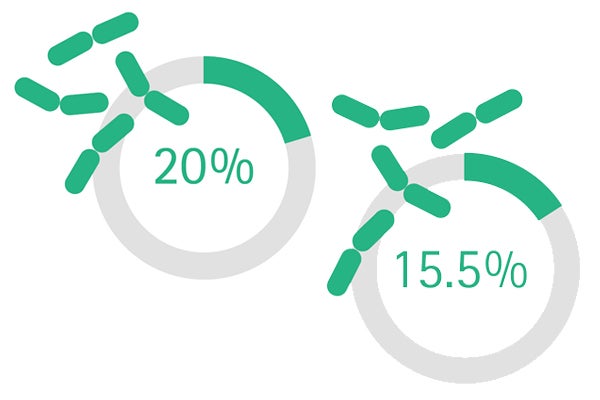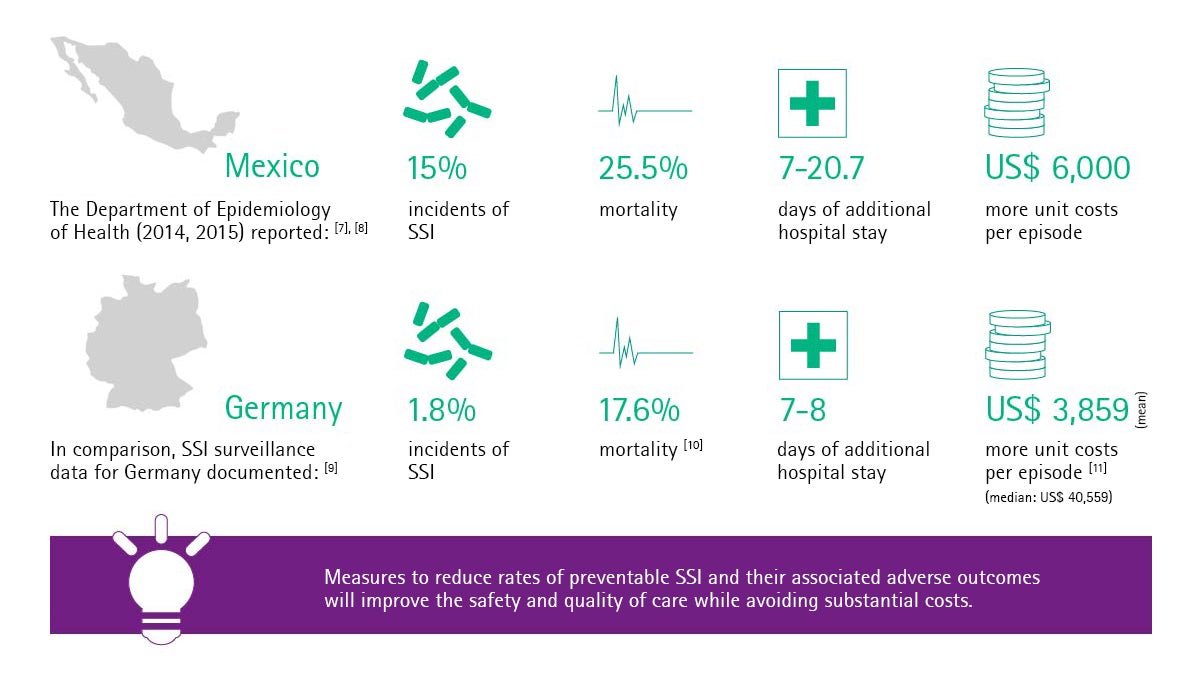TOM rocks! Tray Organizing Manager
Choose a category or subcategory
Economic consequences of surgical site infection (SSI)
Health care-associated infections (HAIs), especially surgical site infections (SSIs), represent a serious public health problem due to the high rates of morbidityand mortality that occur in conjunction with them. SSIs are among the most common preventable health adverse events and produce direct and indirect costs and prolonged hospital stays. [1]
SSI is one of the most common complications associated with surgery and affects approximately 10% of the patients in low- and middle-income countries. [2] (12.3% of patients worldwide after gastrointestinal surgery.) [3]
In the US, about 20% of HAIs are attributed to infection of a surgical site. [4], [5]
In Brazil, the Sao Paulo Nosocomial Infection Studies and Control Association observed SSIs being the second most frequent type of hospital infections (15.5%). [6]
SSI also adds costs in the healthcare setting in Latin America [6]
Infection Prevention Starts with TOM
Choose a category or subcategory
Let TOM rock your CSSD!
TOM is our all new digital Tray Organizing Manager – an easy to install app-based platform solution designed to optimize the processes of any CSSD.
We at B. Braun have significant understanding of hospital workflows and process management, recognizing current trends and market developments. Using these insights we develop solutions to help you to reduce costs and improve patient safety.
One of these solutions is TOM, providing key functionality for hospitals and outpatient clinics that do not yet have a digital instrument management system. With the tap of a finger, TOM handles all classic CSSD processes such as set packing, reporting of defective instruments, and checking on packed sets.
Digitalization – The Smart Way!
Change your Ways
Change your Ways
TOM rocks… and helps you to rock your workplace
Kick your count sheets out and invite TOM in!
Say goodbye to piles of files and shelves full of set lists! Say hello to TOM, the modern digital tray organizing solution for your CSSD.
TOM, the tablet- and cloud-based application, assists in performing everyday processes such as packing, tracking, documenting and reporting – all of which are processes modern CSSDs have in common.
The aim of TOM is to deliver smartly presented data, when you need it, where you need it – always accessible, always updated, always transparent.
Get TOM and get rocking in your paperless CSSD!
Your Digital Solution
Your Digital Solution
TOM rocks… and helps you digitalize your CSSD
Today the global mega trend of digitalization is a driver of automation and efficiency. To keep with the beat, every medical institution needs to stay in sync with the data that it is using and producing.
TOM is our digital solution for you to take control and gain insights on your everyday-processes, as TOM is generating, collecting and analyzing data of all reprocessing activities in real-time.
For the first time you can truly tune into the mega trend of digitalization and have access to information on the utilization and capacity of your CSSD department in real-time.
Let TOM rock your organization, bringing digital power to the CSSD!
Easy to Implement
Easy to Implement
TOM rocks… and helps you to bring your CSSD back on stage
Bring your CSSD up to speed with TOM, the new digital tray organizing manager.
You can configure TOM the way you need it, orchestrating and administering your set list by a simple click of a mouse or flick of a finger. Each packing station is equipped with a tablet, granting instant and easy cloud-based access to the latest set lists, instrument pictures, handling, cleaning and assembly instructions.
It´s simple – download the app, register and start rocking with TOM!
Info graph as poster download
[1] Umscheid CA, Mitchell MD, Doshi JA, Agarwal R, Williams K, Brennan PJ. Infect Control Hosp Epidemiol. Estimating the proportion of healthcare-associated infections that are reasonably preventable and the related mortality and costs. 2011 Feb;32(2):101-14. doi:10.1086/657912.
[2] WHO Protocol for surgical site infection surveillance with a focus on settings with limited resources, 2018.
[3] GlobalSurg Collaborative. Surgical site infection after gastrointestinal surgery in high-income, middle-income, and low-income countries: a prospective, international, multicentre cohort study Lancet Infect Dis. 2018 May; 18(5):516-525.
[4] De Lissovoy G, Fraeman K, Hutchins V, Murphy D, Song D, Vaughn BB. Surgical site infection: Incidence and impact on hospital utilization and treatment costs Am J Infect Control. 2009 Jun;37(5):387-397.
[5] Klevens RM, Edwards JR, Richards CL Jr, Horan TC, Gaynes RP, Pollock DA et al. Estimating health care-associated infections and deaths in U.S. hospitals, 2002. Public Health Rep. 2007 Mar-Apr; 122(2):160-166.
[6] Dal-Paz K, Oliveira P, de Paula A, Emerick MC, Pecora JR, Lima AL, Economic impact of treatment for surgical site infections in cases of total knee arthroplasty in a tertiary public hospital in Brazil. The Brazilian Journal of Infectious Diseases.2010, v.14, n.4, p.356-359.
[7] Zamudio J, Surgical wound irrigation: strategy for prevention of surgical site infection. Nurse Care Open Acces J. 2017;3(1):201-202.
[8] Ministry of Health México. Measurement of the prevalence of nosocomial infections in general hospitals of the main public health institutions; 2011.
[9] S1-Leitlinie: Strategien zur Prävention postoperativer Wundinfektionen.
[10] Badia JM, Casey AL, Petrosillo N, Hudson PM, Mitchell SA, Crosby C. Impact of surgical site infection on healthcare costs and patient outcomes: a systematic review in six European countries. J Hosp Infect. 2017 May;96(1):1-15.
[11] Graf K, Ott E, Vonberg RP, Kuehn C, Schilling T, Haverich A, Chaberny IF. Surgical site infections-economic consequences for the health care system. Langenbecks Arch Surg. 2011;396:453-9.





